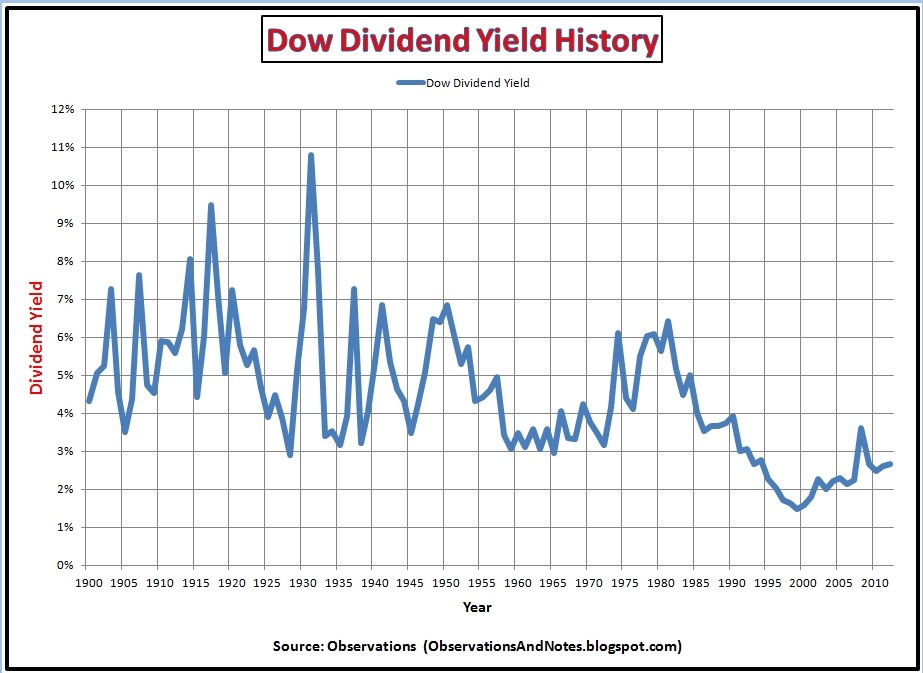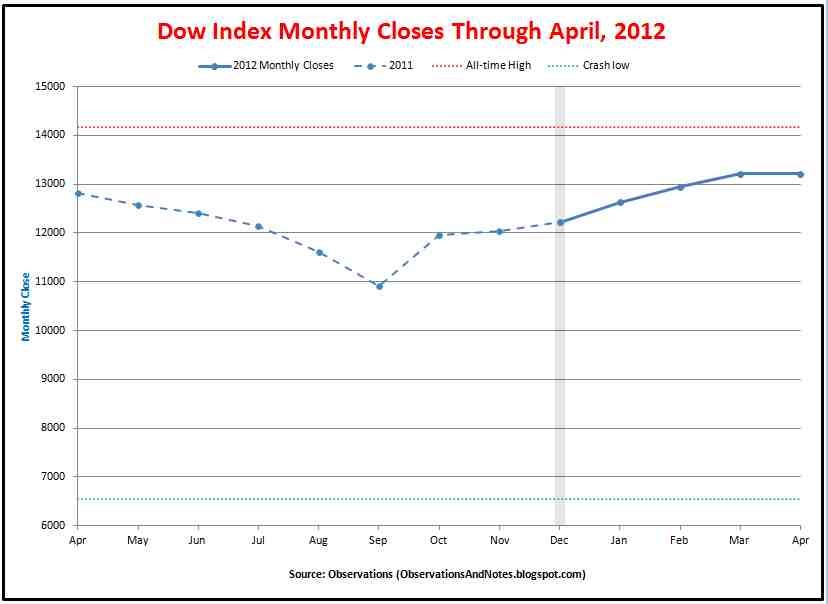Observations Best Worst 10Year Returns in Stock Market History (thru 2012)
Post on: 28 Март, 2015 No Comment

Monday, April 6, 2009
Best & Worst 10-Year Returns in Stock Market History (thru 2012)
10-Year Rolling Returns (Decade Returns)
This post graphs not only the best and worst decades in stock market history, but returns for all 10-year periods since around 1900; these are so-called 10-year rolling returns .
Stock Market Rolling 10-Year Returns Graph
Dow 10-Year Rolling Returns
Above is a graph of the 10-year total return of the DJIA (Dow Jones Industrial Average) beginning around 1900. (Note: Click on graph to expand it.) Each point on the graph represents the average annual return earned by a hypothetical investor who bought the Dow at that year-end and sold 10 years later, reinvesting dividends in the interim. For example, the first point on the graph shows that an investor who bought at year-end 1900, reinvested dividends annually, and sold at year-end 1910 earned 6.8% per year. Note that the returns prior to 1929 are estimated (which is why I sometimes omit them).
Stock Market Returns for a Decade are Cyclical, and Can be Negative
This is the same data as was used for the 10-year return histogram in the Stock Market Yearly Returns since 1929 post. However, this presentation gives us a significantly different impression. The histogram left us with the impression that 10-year returns have been consistently between 0% and 20%, and much less variable than yearly returns. That’s true. However, that presentation was incomplete because:
- It completely hides the cyclicality.
- It started in 1929 and missed the fact that 10-year returns can in fact be negative (a key reason why I started in 1901 for this post)
- It wasn’t as clear how often returns are almost zero
Note: This is another example of the boom and bust nature of the stock market alluded to in the discussion of the graph in 100 Years of Stock Market History .
The Best and Worst 10-Year Returns in Dow Jones History (since 1900)
So, what were the best & worst 10-year periods to own stocks? That is, in hindsight, when would have been the best and worst years to buy?
The best 10-year periods to own stocks were the years beginning in:
- 1918: the return was about 19.5% per year for the next 10 years
- 1948 & 49: 18.5% annual return
- 1987 & 88: about 18.5% annual return
The worst years to buy were:
- 1922: the return was 0.4% per year for the next 10 years
- 1928: -1.3% annual return — the only 10-year loss in my data; 1927 & 1929 were both just barely positive. All because of the 1929-1932 stock market crash .
- 1964: annual return of 0.3%

Note: FYI, the decades ending in 2008 and 2009 didn’t make the above list, but they’re next. The decade ending in 2009 is 6th at 1.3%; 2008 is 7th at 1.7%. For the most recent 10 years, ending 2012, the return was 7.2%.
Average Returns for a Decade, and the Impact of Inflation & Expenses
On average, stock market returns for a decade were around 10% per year. However, the 10-year returns varied considerably, depending on your start year.
The graph shows several instances of near-zero 10-year returns. To my way of thinking, a decade is a long time to go with essentially no return on your investment. In addition, there were a number of 10-year periods with returns of 5% or less. Remember, these returns have not been adjusted for inflation. If you assume that over this period inflation has averaged about 3% per year, then the less than 5% nominal returns become less than 2% in real terms, and the near-zero returns become negative. (For a more detailed discussion of nominal vs real rates of return, see this post .)
A Better Way to Look at Stock Market Returns — Especially for Retirement Planning
The graph above should make it clear that investors don’t always get average returns! Sometimes returns are above average; sometimes returns are below average. What if the market returns only 5 or 6% in the next 10 years instead of 10%? What are the chances of that? What impact would that have on your retirement portfolio? See What Will a $10,000 Stock Market Investment be Worth in 10 Years?. You may be surprised.
Related Posts:
What’s Causing the Cycles (variation in returns)?
10-Year Rolling Returns vs P/E Ratio. The above graph with addition of the P/E ratio at the beginning of each 10-year period.
Starting P/E Ratio vs. 10-Year Returns. Shows the 10-year returns that resulted from each initial P/E ratio. The classic way to investigate causation.
Components of 10-Year Returns. Breaks out how much of each 10-year return came from a) dividends, b) earnings growth and c) change in valuation.
How the Stock Market Projection Model Works using this information to project returns for the next 10 years.
Other Best & Worst Returns
Stock Market Compound Growth Calculator. Calculates growth/return rate between any 2 prior years — e.g. between 1974 and 1999.
Range of Results in Dollars for 10-100 Years. the variability in the sizes of the ending portfolios is surprising.
For a list of other popular posts and an index of stock market posts by subject area, see the sidebar on the left or the blog header at the top of the page.
Note: The above charts are based on DJIA (Dow Jones Industrial Average) data from my Stock Market Analysis Spreadsheet/Model. If you have trouble downloading the Excel spreadsheet, see this post. Results would be essentially the same if we used S&P 500 data. Dividends prior to 1929 have been estimated based upon another stock market index.
Share This Article
To share via Facebook, Twitter, etc. see below.














